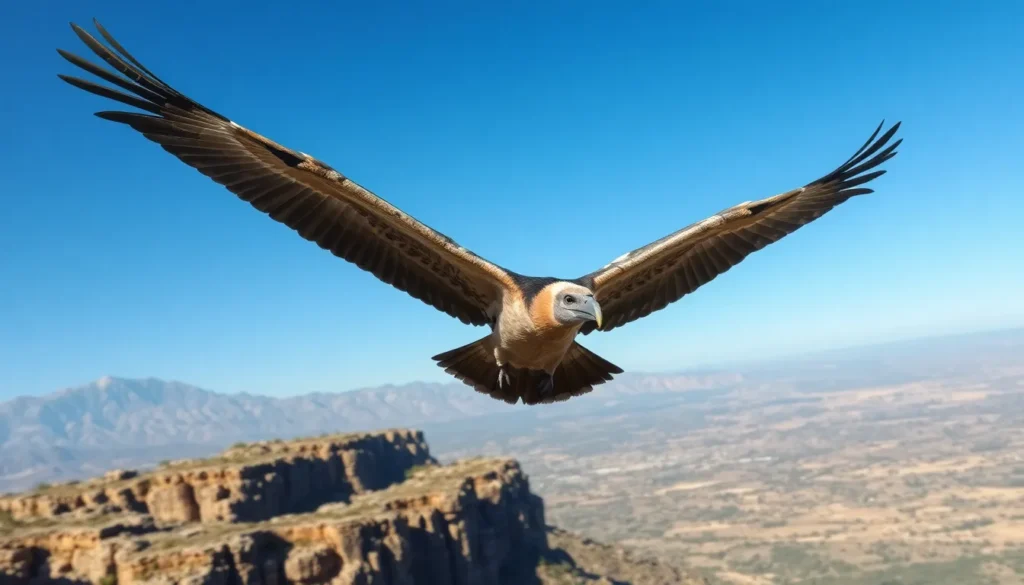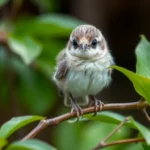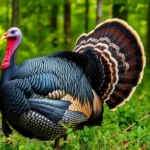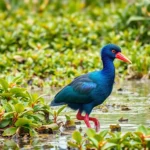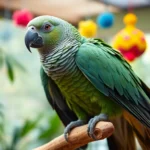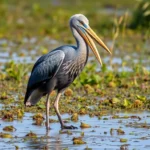We’ve all seen them circling ominously overhead in movies, but vultures are far more fascinating than their Hollywood reputation suggests. These remarkable scavengers play a crucial role in maintaining healthy ecosystems across six continents, serving as nature’s ultimate cleanup crew.
Vultures possess extraordinary adaptations that make them perfectly suited for their unique lifestyle. From their powerful digestive systems that neutralize deadly bacteria to their incredible soaring abilities that allow them to cover hundreds of miles while searching for food, these birds represent millions of years of evolutionary perfection.
Unfortunately, vulture populations worldwide face unprecedented threats from habitat loss, poisoning, and human interference. Understanding these magnificent creatures isn’t just about appreciating wildlife – it’s about recognizing their vital contribution to environmental health and our shared responsibility to protect them. Let’s explore the remarkable industry of vultures and discover why they deserve our respect and conservation efforts.
Physical Characteristics of the Vulture Bird
Vulture birds exhibit remarkable physical adaptations that enable their specialized scavenging lifestyle. These impressive raptors display distinctive features that set them apart from other bird species.
Size and Wingspan
Vulture birds rank among the largest flying birds in the industry. The Andean condor reaches wingspans of 10.5 feet, making it one of the most impressive soaring species on Earth.
Different vulture species vary significantly in size measurements:
| Species | Wingspan | Body Length | Weight |
|---|---|---|---|
| Andean Condor | 9.8-10.5 feet | 3.3-4.3 feet | 17-33 pounds |
| California Condor | 8.2-9.8 feet | 3.6-4.5 feet | 15-31 pounds |
| Griffon Vulture | 7.7-9.4 feet | 3.1-3.8 feet | 13-26 pounds |
| Turkey Vulture | 5.6-6 feet | 2.2-2.7 feet | 2-5 pounds |
Large vulture species like the Eurasian black vulture can weigh up to 31 pounds. Smaller species such as the hooded vulture typically weigh between 3-5 pounds. Most vultures possess broad wings designed for efficient soaring over long distances while searching for carrion.
Distinctive Features and Adaptations
Vulture birds possess unique anatomical features that support their scavenging behavior. Bald heads characterize most vulture species, preventing bacteria and parasites from accumulating in feathers when feeding on carcasses.
Sharp curved beaks enable vultures to tear through tough animal hides and access meat efficiently. Strong stomach acid with pH levels as low as 1.0 allows vultures to digest decomposing meat and neutralize harmful bacteria that would kill other animals.
Exceptional eyesight helps vultures spot carrion from distances exceeding 3 miles. Keen olfactory senses in species like turkey vultures detect the scent of decaying flesh from over a mile away. Long necks allow vultures to reach deep inside large carcasses without contaminating their body feathers.
Powerful legs and talons provide stability while feeding on the ground rather than capturing live prey. Specialized flight feathers create efficient lift generation, enabling vultures to soar for hours with minimal energy expenditure while covering vast territories in search of food sources.
Vulture Bird Species Around the World
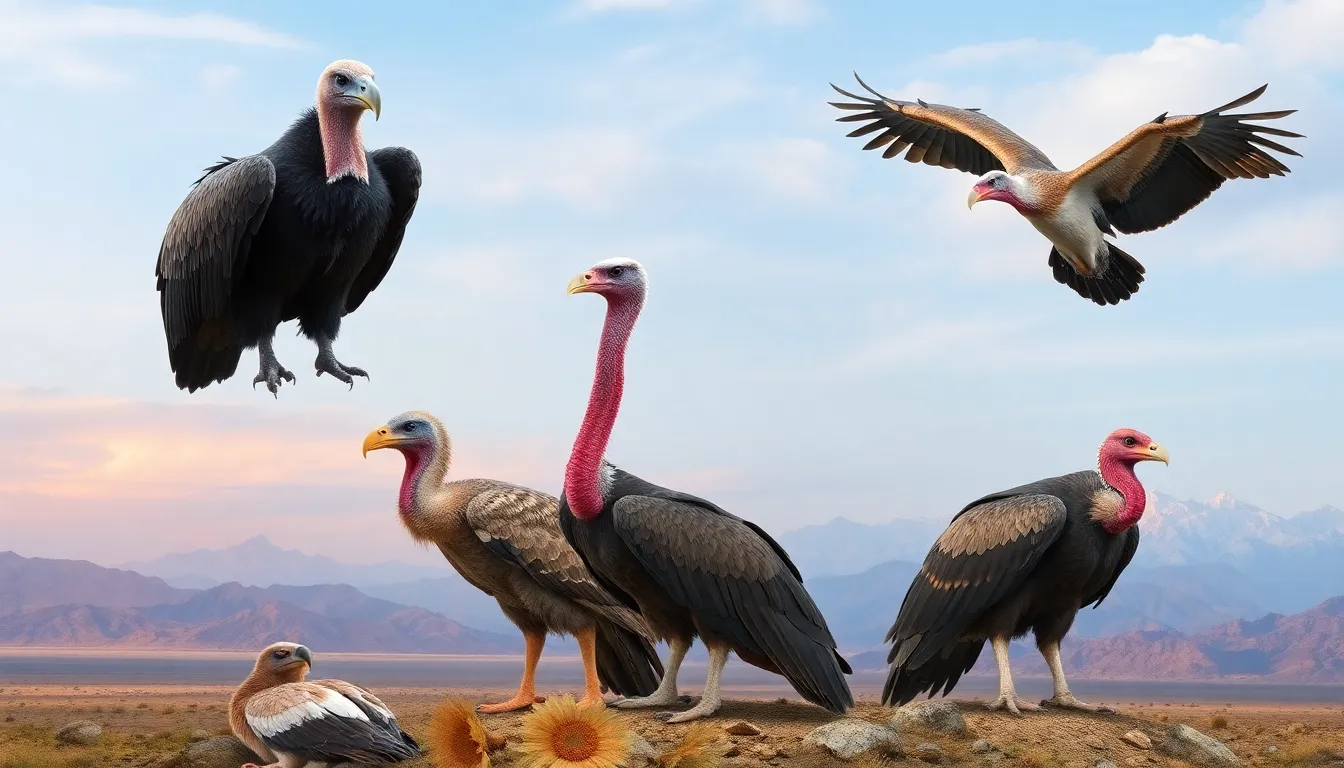
Vulture birds exist across every continent except Antarctica and Australia, with 23 distinct species divided into two major groups based on their geographic origins and evolutionary lineages. These remarkable scavengers have adapted to diverse environments ranging from African savannas to South American mountain ranges.
Old Industry Vultures
Old Industry vultures comprise 16 species found throughout Africa, Asia, and Europe, representing the family Accipitridae alongside eagles and hawks. Africa hosts the greatest diversity with 11 species including the massive lappet-faced vulture (Torgos tracheliotos) that reaches weights of 20 pounds and the smaller hooded vulture (Necrosyrtes monachus) weighing just 3.3 pounds.
European populations include three primary species: the griffon vulture (Gyps fulvus), the cinereous vulture (Aegypius monachus), and the bearded vulture (Gypaetus barbatus). Griffon vultures maintain the largest European populations with approximately 25,000 breeding pairs concentrated in Spain’s mountainous regions.
Asian vultures face the most severe conservation challenges among Old Industry species, with populations declining by over 97% since the 1990s. The white-rumped vulture (Gyps bengalensis) once numbered in tens of millions but now survives in isolated pockets across the Indian subcontinent. Indian vultures (Gyps indicus) and slender-billed vultures (Gyps tenuirostris) share similar population crashes due to diclofenac poisoning from livestock carcasses.
New Industry Vultures
New Industry vultures consist of 7 species belonging to the family Cathartidae, distributed across the Americas from southern Canada to Argentina. These vultures differ significantly from their Old Industry counterparts through enhanced olfactory capabilities and different evolutionary origins.
Turkey vultures (Cathartes aura) represent the most widespread New Industry species, inhabiting diverse ecosystems from Canadian forests to Patagonian grasslands. Black vultures (Coragyps atratus) dominate southeastern United States and Central American regions, often outcompeting turkey vultures through aggressive social behavior and superior numbers at carcass sites.
Andean condors (Vultur gryphus) reign as the largest vulture species globally, with wingspans reaching 10.5 feet and weights approaching 33 pounds in males. These giants soar along South American mountain ranges from Venezuela to Chile, utilizing thermal updrafts to cover distances exceeding 100 miles daily while searching for carrion.
California condors (Gymnogyps californianus) represent conservation success stories, recovering from just 27 individuals in 1987 to over 500 birds today through intensive captive breeding programs. King vultures (Sarcoramphus papa) display the most colorful plumage among New Industry species, featuring vibrant orange and purple facial skin that contrasts sharply with their white and black feathers across Central and South American tropical forests.
Habitat and Distribution
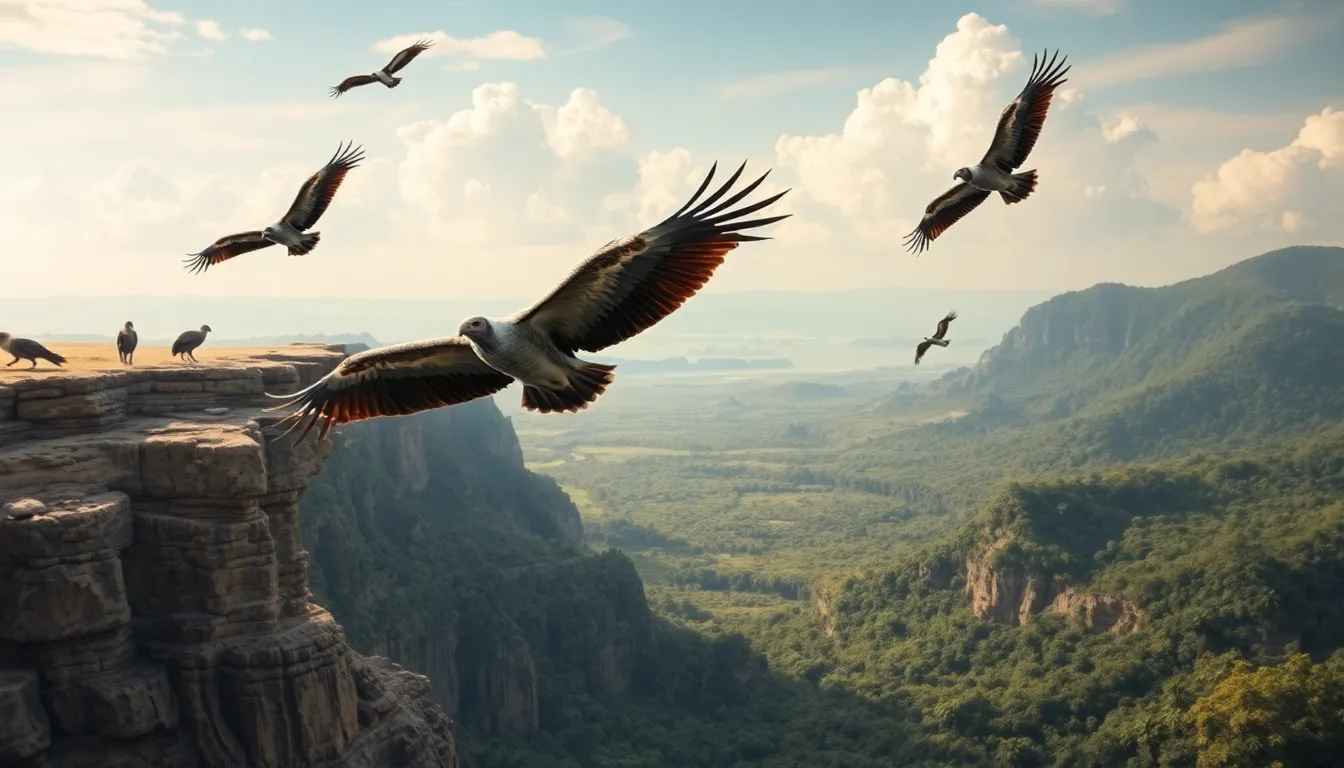
Vultures occupy diverse ecosystems across six continents, adapting to environments ranging from scorching deserts to towering mountain peaks. These remarkable scavengers demonstrate exceptional flexibility in their habitat preferences, thriving in both pristine wilderness areas and human-modified landscapes.
Natural Environments
Vultures inhabit an extraordinary range of natural environments that support their scavenging lifestyle. Open savannas provide optimal hunting grounds where these birds can spot carrion from altitudes exceeding 15,000 feet. Rocky cliffs and canyon walls serve as preferred nesting sites for species like the bearded vulture, which builds its nests on ledges up to 9,800 feet above sea level.
Desert regions attract multiple vulture species due to abundant thermal currents that reduce energy expenditure during flight. The Egyptian vulture thrives in arid landscapes across North Africa and the Middle East, utilizing rocky outcrops for roosting and breeding. Mountain ranges support specialized species such as the Andean condor, which soars above peaks reaching 18,000 feet in elevation.
Tropical forests host turkey vultures and king vultures, which navigate dense canopies using their enhanced sense of smell to locate decomposing matter. Agricultural areas increasingly serve as feeding grounds for adaptable species like the hooded vulture, which benefits from livestock mortality in pastoral regions.
Geographic Range
Vulture distribution spans five continents with distinct regional concentrations. Africa hosts the greatest diversity with 11 Old Industry species, including the massive lappet-faced vulture that ranges across sub-Saharan regions from Senegal to Somalia. European populations center in the Mediterranean basin, where griffon vultures maintain stable colonies in Spain, France, and the Balkans.
Asian vultures face the most restricted ranges due to population crashes exceeding 99% since the 1990s. The oriental white-backed vulture once numbered in millions across the Indian subcontinent but now survives in fragmented populations across Cambodia, Myanmar, and northern India. Critical breeding sites remain in Nepal’s protected areas and Assam’s national parks.
North American vultures occupy territories from southern Canada to northern Mexico. Turkey vultures demonstrate the widest distribution among New Industry species, inhabiting regions from British Columbia to the southern United States year-round. California condors exist only in carefully managed populations across California, Arizona, and Baja California after near-extinction in the 1980s.
South American species dominate the Andean mountain chain and surrounding lowlands. The Andean condor ranges from Venezuela to southern Chile, utilizing updrafts along the entire Pacific coast mountain system. King vultures inhabit tropical forests from southern Mexico through northern Argentina, preferring lowland rainforest environments below 4,900 feet elevation.
Feeding Behavior and Diet
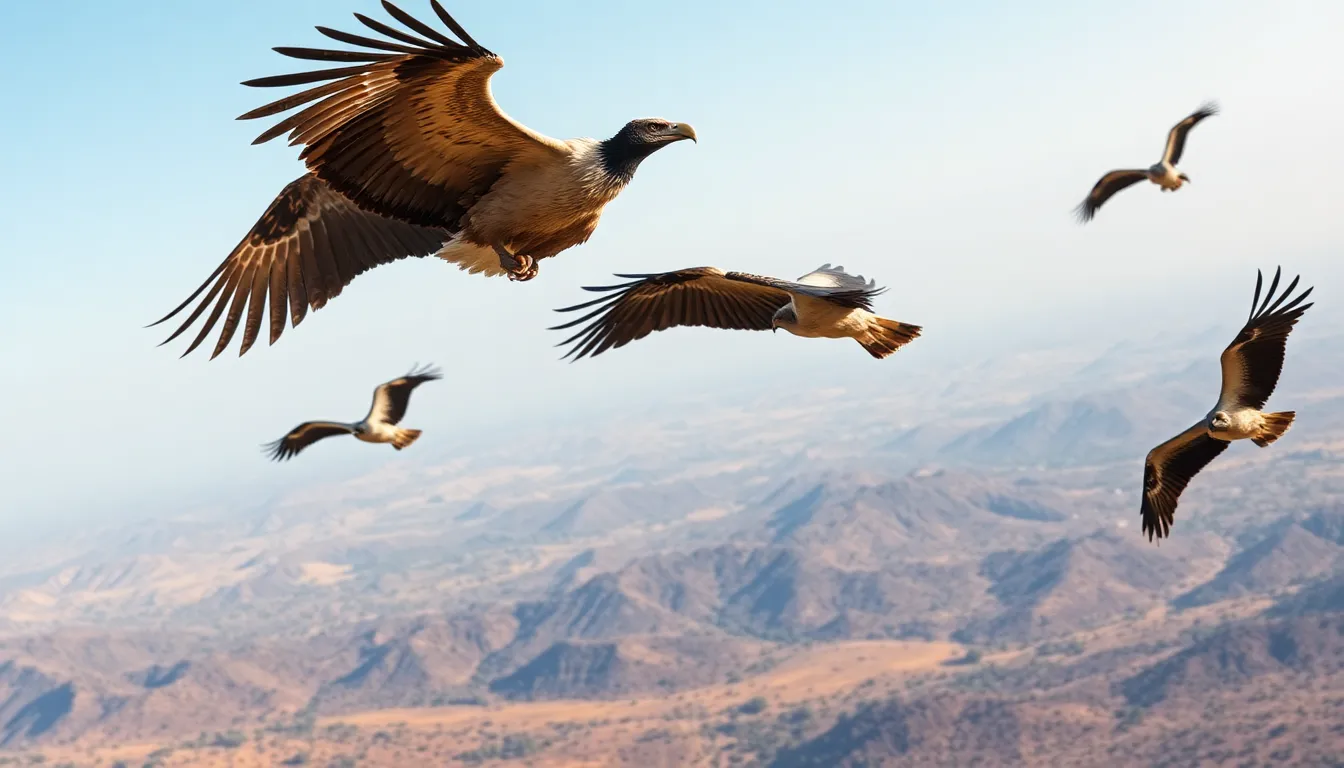
Vultures demonstrate specialized feeding behaviors that make them nature’s most efficient cleanup crew. These remarkable scavengers consume carrion exclusively, processing decomposing organic matter with remarkable efficiency.
Scavenging Techniques
Vultures employ sophisticated detection methods to locate food sources across vast territories. Visual scanning dominates their hunting strategy, with species like griffon vultures soaring at altitudes exceeding 20,000 feet while scanning landscapes below. Olfactory detection provides New Industry vultures with enhanced capabilities, allowing turkey vultures to detect ethyl mercaptan gases from decomposing carcasses at distances up to 8 miles.
Group feeding dynamics create efficient processing systems at carrion sites. Larger species including cinereous vultures and lappet-faced vultures access carcasses first, using powerful beaks to tear through tough hides and access internal organs. Medium-sized species like white-backed vultures follow next, consuming soft tissues and muscle meat. Smaller vultures finish the cleanup process by picking remaining scraps from bones.
Feeding hierarchies emerge naturally based on beak strength and body size. Bearded vultures specialize in bone marrow extraction, dropping large bones from heights of 150-200 feet onto rocks to crack them open. Egyptian vultures demonstrate tool use by throwing stones at ostrich eggs to break shells and access contents.
Temperature tolerance allows vultures to feed during extreme conditions when other scavengers cannot. Vultures consume food at temperatures reaching 140°F, with stomach acid pH levels between 1.0-1.5 destroying harmful bacteria and pathogens that would kill other animals.
Role in Network Cleanup
Vultures process approximately 70% of available carrion in ecosystems where they’re present. Disease prevention occurs through their consumption of infected carcasses, with vulture digestive systems neutralizing anthrax, cholera, and rabies pathogens before they spread to water sources or other wildlife.
Nutrient cycling accelerates when vultures break down organic matter rapidly. A single vulture colony processes 3-4 tons of carrion annually, converting decomposing flesh into fertilizer that enriches soil systems. Bone disposal by bearded vultures eliminates calcium buildup in ecosystems, preventing environmental imbalances.
Competition reduction benefits other scavengers by removing large carcasses quickly. Vultures complete carcass processing 3-5 times faster than bacterial decomposition alone, reducing habitat conflicts between competing species like hyenas, jackals, and wild dogs.
| Network Service | Processing Rate | Environmental Impact |
|---|---|---|
| Pathogen elimination | 99.9% bacteria destruction | Disease outbreak prevention |
| Carrion processing | 15-20 pounds per day per bird | Rapid organic matter removal |
| Nutrient distribution | 4 square mile foraging range | Soil fertilization across landscapes |
| Bone breakdown | 80% calcium extraction | Mineral recycling efficiency |
Water source protection occurs when vultures prevent carrion contamination of rivers and streams. Their rapid consumption eliminates bacterial growth that would otherwise pollute aquatic ecosystems and threaten wildlife populations dependent on clean water sources.
Social Behavior and Flight Patterns
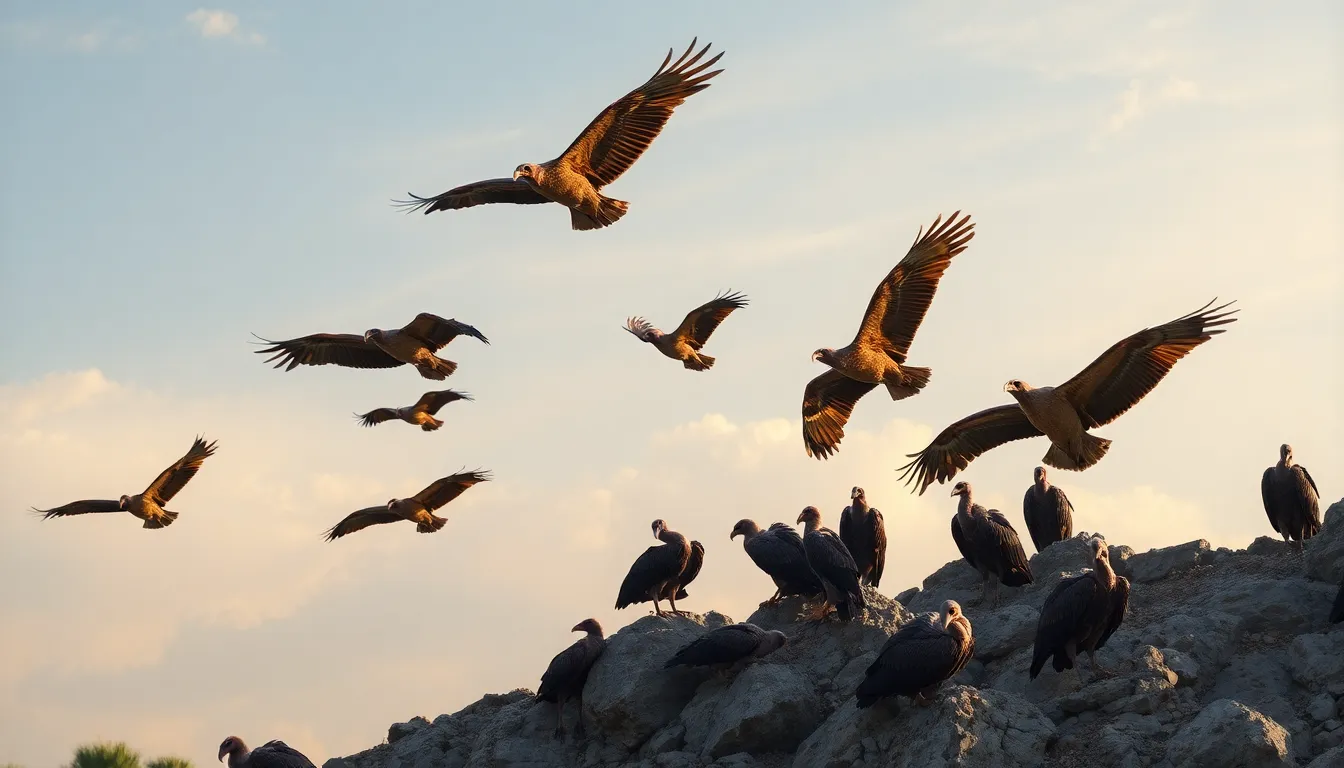
Vultures demonstrate complex social behaviors that directly influence their survival strategies and feeding success. These remarkable scavenging birds combine sophisticated group interactions with extraordinary aerial capabilities to maximize their effectiveness as nature’s cleanup specialists.
Group Dynamics
Vultures organize themselves into hierarchical social structures that determine feeding order and territorial access. Turkey vultures typically form loose aggregations of 8 to 12 birds during feeding sessions, while larger species like griffon vultures gather in groups exceeding 100 individuals at substantial carcasses.
Feeding hierarchies operate based on species dominance and body size, with larger vultures claiming priority access to carrion. Bearded vultures and cinereous vultures dominate smaller species through aggressive posturing and physical displacement tactics. King vultures use their powerful beaks and imposing presence to establish feeding rights over black vultures and turkey vultures.
Roosting behaviors reveal extensive communal patterns among vulture populations. Egyptian vultures congregate in shared roosting sites containing 20 to 50 individuals, while cape vultures establish communal roosts housing over 1,000 birds during peak seasons. These gathering spots help information exchange about food sources and provide protection through collective vigilance.
Communication methods include visual displays, vocalizations, and chemical signals that coordinate group activities. Vultures use head bobbing, wing spreading, and aggressive lunging to establish dominance during feeding encounters. White-backed vultures emit hissing sounds and bill rattling to communicate territorial boundaries and warn competitors.
Soaring and Thermal Riding
Vultures exploit thermal air currents with exceptional precision to minimize energy expenditure during extended flights. These birds can soar continuously for 6 to 8 hours without flapping their wings by riding rising columns of warm air called thermals.
Thermal detection abilities allow vultures to locate ascending air currents from distances exceeding 3 miles. Andean condors identify thermals through subtle visual cues like dust particles, cloud formations, and surface heat distortions. Turkey vultures detect thermal activity by observing the flight patterns of other soaring birds and adjusting their routes accordingly.
Flight efficiency statistics demonstrate remarkable energy conservation among vulture species. Griffon vultures maintain airspeeds of 22 to 28 mph while gaining altitude at rates of 500 to 800 feet per minute within strong thermals. California condors achieve glide ratios of 20:1, meaning they travel 20 feet horizontally for every foot of altitude lost during non-thermal flight.
Altitude capabilities vary significantly across vulture species based on their geographic ranges and hunting strategies. Rüppell’s griffon vultures soar at altitudes reaching 37,000 feet, making them among the highest-flying birds on Earth. Himalayan griffon vultures regularly patrol mountain ranges at elevations between 15,000 and 20,000 feet while scanning for carrion across vast territorial ranges.
Formation flying patterns enhance thermal utilization and reduce individual energy costs during long-distance movements. Vultures arrange themselves in loose V-formations or spiral clusters within thermal columns to maximize lift benefits. These coordinated flight behaviors allow entire groups to gain altitude simultaneously while maintaining visual contact for food source communication.
Reproduction and Life Cycle
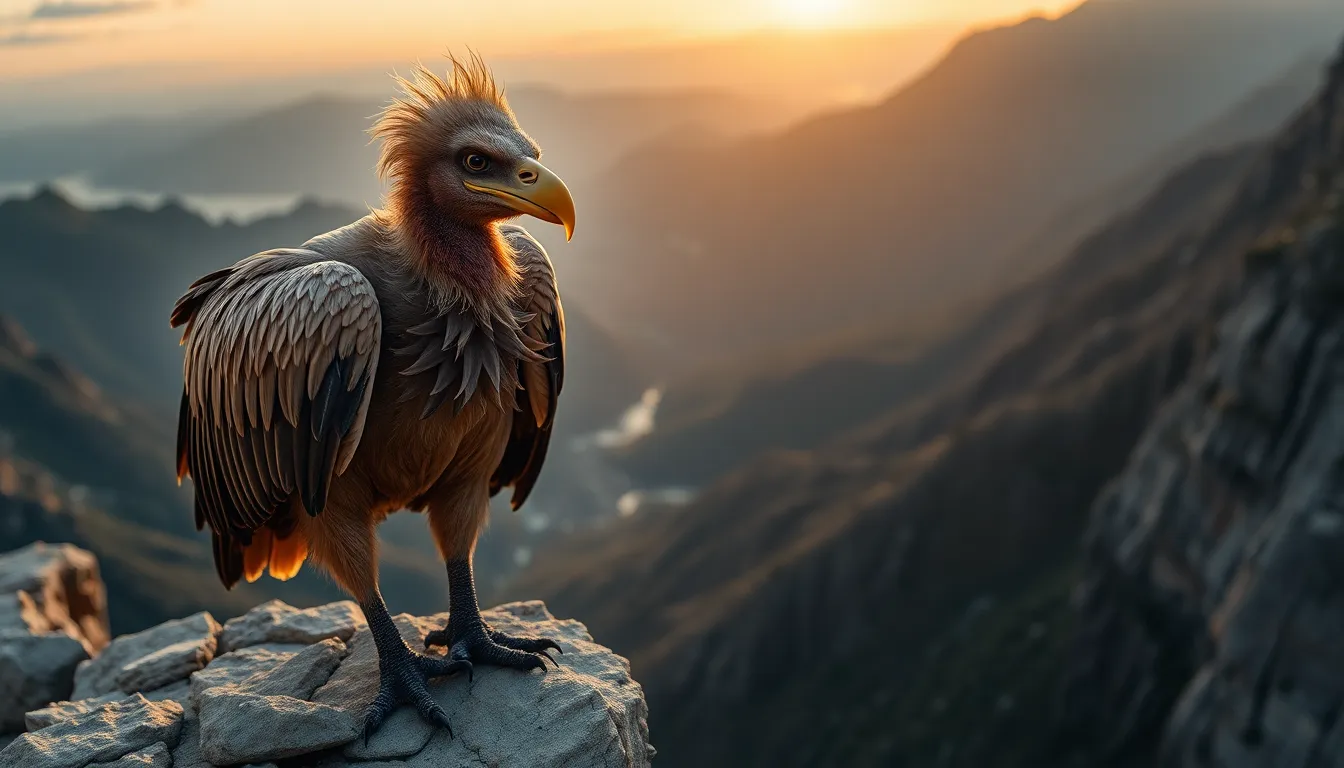
Vultures follow unique reproductive strategies that reflect their specialized ecological role as nature’s primary scavengers. Their breeding cycles and nesting behaviors have evolved to maximize offspring survival in challenging environments.
Nesting Habits
Vultures select nesting sites based on safety requirements and accessibility to food sources. Cliff faces provide the most common nesting locations for species like griffon vultures and bearded vultures, offering protection from ground predators and optimal launch points for soaring flights. Tree cavities serve as alternative nesting sites for smaller species such as hooded vultures in African woodlands.
Ground nesting occurs among certain species including Egyptian vultures, which create shallow scrapes in rocky crevices or cave entrances. These locations offer thermal regulation benefits and concealment from aerial threats. New Industry vultures like turkey vultures use hollow logs, abandoned buildings, and dense vegetation for nest placement.
Nest construction varies significantly across vulture species and available materials. Old Industry vultures build substantial stick platforms measuring 3 to 6 feet in diameter, reinforced with grass, leaves, and animal fur. These structures can weigh up to 200 pounds after years of annual additions and repairs.
Communal nesting sites develop when multiple breeding pairs establish territories within close proximity. Ruppell’s vultures create colonies containing 50 to 100 active nests on suitable cliff faces. Social nesting provides enhanced predator detection and cooperative defense of breeding areas.
Breeding Patterns
Vultures reach sexual maturity between 4 to 8 years of age depending on species size and environmental conditions. Larger species like Andean condors mature later at 6 to 8 years, while smaller vultures achieve breeding capability by 4 to 5 years of age.
Monogamous pair bonds characterize most vulture species, with partnerships lasting multiple breeding seasons or entire lifetimes. Courtship displays involve aerial acrobatics, synchronized soaring, and ritualized feeding behaviors that strengthen pair bonds and assess mate fitness.
Breeding seasons align with optimal food availability and favorable weather patterns in each geographic region. African vultures typically breed during dry seasons from October to March when carcass visibility increases and thermal conditions support extended foraging flights. European populations breed from February to July, coinciding with spring abundance of prey animals.
Egg laying patterns show remarkable consistency across vulture families. Most species produce 1 to 2 eggs per breeding attempt, with single eggs being most common among larger species. Incubation periods range from 38 to 55 days, with both parents sharing brooding responsibilities in alternating shifts.
Chick development follows extended timelines that reflect the specialized nature of scavenging lifestyles. Fledgling periods extend from 70 to 180 days depending on species, with young vultures remaining dependent on parental care for 6 to 12 months after first flight. This prolonged development period allows offspring to develop essential soaring skills and learn complex foraging techniques through parental guidance.
Conservation Status and Threats
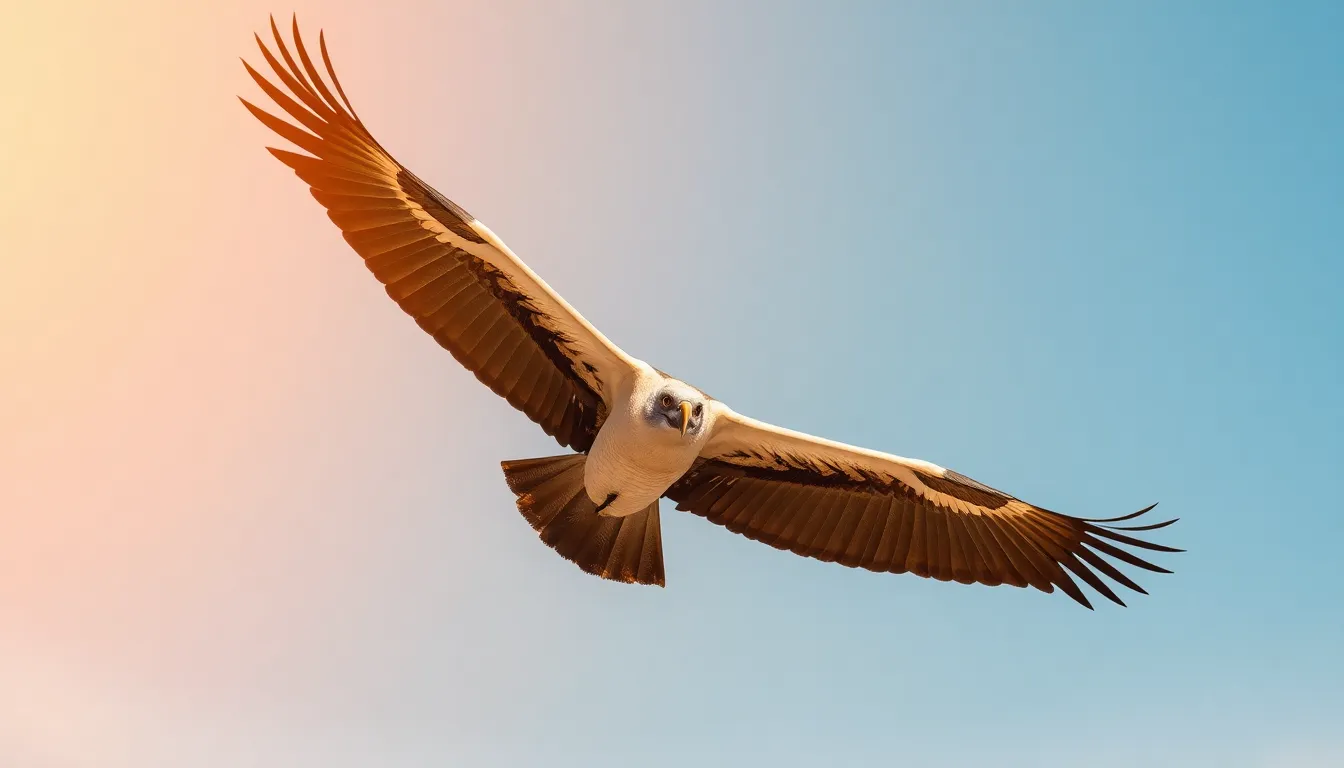
Vulture populations face unprecedented decline across the globe, with many species teetering on the brink of extinction. Critical conservation challenges threaten these essential network guardians through multiple interconnected factors.
Endangered Species
Nine vulture species currently appear on the IUCN Red List as critically endangered, representing the most severe conservation crisis among large birds. Asian vultures experienced catastrophic population declines exceeding 99% between 1990 and 2007, primarily affecting white-backed vultures, long-billed vultures, and slender-billed vultures.
| Species | Conservation Status | Population Decline |
|---|---|---|
| White-backed Vulture | Critically Endangered | 99.9% since 1990 |
| Long-billed Vulture | Critically Endangered | 97% since 1990 |
| Slender-billed Vulture | Critically Endangered | 99% since 1990 |
| California Condor | Critically Endangered | 22 individuals in 1987 |
| Egyptian Vulture | Endangered | 50% decline over 3 generations |
California condors represent conservation success stories, recovering from 22 individuals in 1987 to approximately 537 birds today through intensive captive breeding programs. European populations of griffon vultures show stable numbers in protected areas like Spain’s national parks. African vulture species face varying degrees of threat, with hooded vultures declining by 62% over three generations according to recent surveys.
Diclofenac poisoning remains the primary threat to Asian vulture populations, causing kidney failure within days of consumption. Veterinary drugs containing diclofenac accumulated in livestock carcasses throughout India and Pakistan during the 1990s. Meloxicam and other non-steroidal anti-inflammatory drugs continue threatening vulture recovery even though diclofenac bans in several countries.
Human Impact and Habitat Loss
Agricultural expansion eliminates traditional vulture foraging grounds across Africa, Asia, and South America, reducing available carrion sources by 30-40% in affected regions. Livestock management practices increasingly remove carcasses from natural environments, disrupting established vulture feeding patterns.
Power line collisions kill thousands of vultures annually, particularly affecting large species like cape vultures and cinereous vultures in their primary flight corridors. Wind turbine installations pose growing threats in vulture migration routes, with collision rates varying from 0.3 to 2.7 deaths per turbine per year.
Poisoning incidents targeting predators inadvertently kill vultures consuming poisoned carcasses, creating cascading mortality events affecting entire regional populations. Intentional persecution occurs in some areas where vultures are blamed for livestock deaths or considered omens of misfortune.
Urban development fragments traditional roosting and nesting sites, forcing vultures into suboptimal habitats with reduced breeding success. Climate change alters thermal patterns essential for vulture flight, potentially affecting foraging efficiency and migration routes. Pollution from plastics and heavy metals accumulates in vulture tissues, compromising immune system function and reproductive success.
Human disturbance at nesting colonies causes abandonment rates reaching 40-60% in heavily trafficked areas. Conservation efforts focus on establishing protected corridors, implementing vulture-safe veterinary practices, and creating artificial feeding stations to supplement natural food sources.
Cultural Significance of Vulture Birds
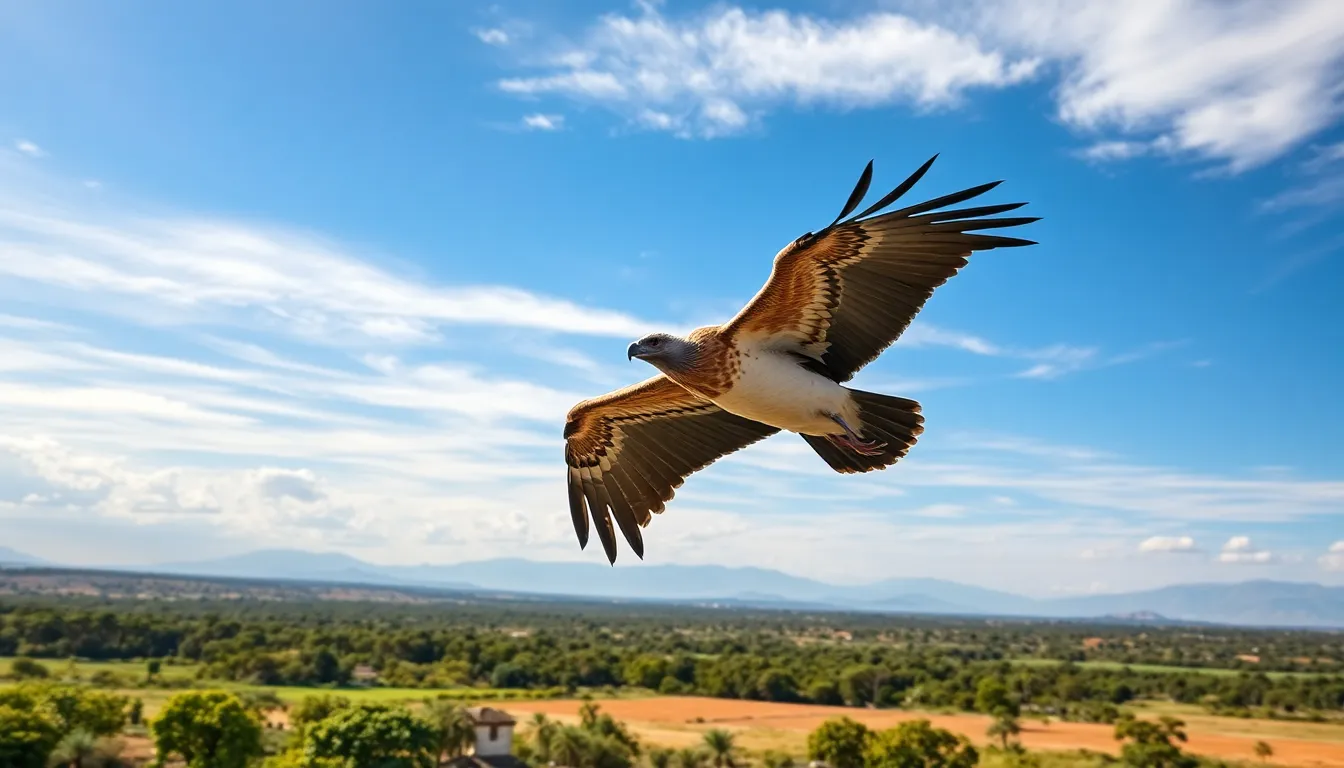
Vulture birds occupy complex positions in human cultures worldwide, representing both revered spiritual symbols and misunderstood creatures across civilizations. These magnificent scavengers have shaped religious beliefs, mythological narratives, and cultural practices for thousands of years.
Mythology and Symbolism
Ancient Egyptian mythology elevated vultures to divine status through the goddess Nekhbet, who protected Upper Egypt and symbolized motherhood, death, and rebirth. Egyptian pharaohs incorporated vulture imagery into royal regalia, believing these birds provided protection during their journey to the afterlife. Greek mythology featured vultures in the story of Prometheus, where Zeus condemned the titan to eternal punishment as a vulture consumed his regenerating liver daily.
Native American cultures view vultures as sacred beings that bridge the physical and spiritual worlds. Cherokee traditions honor vultures as purifiers who cleanse the earth of disease and negative energy. Tibetan Buddhism incorporates vultures into sky burial ceremonies, where these birds consume human remains as part of spiritual recycling that returns the body to nature.
Hindu mythology associates vultures with Garuda, the divine bird who serves as Vishnu’s mount and represents speed, martial prowess, and the fight against evil. Zoroastrian beliefs consider vultures sacred cleaners who prevent soil and water contamination by consuming corpses in “Towers of Silence.”
| Culture | Symbolic Meaning | Religious Role |
|---|---|---|
| Ancient Egypt | Divine protection, rebirth | Royal guardian deity |
| Greek | Punishment, eternal suffering | Mythological torment |
| Native American | Purification, spiritual bridge | Sacred ceremony participant |
| Hindu | Divine transportation | Vehicle of gods |
| Zoroastrian | Sacred cleaner | Ritual burial assistant |
Role in Different Cultures
African cultures demonstrate diverse relationships with vultures across the continent’s many ethnic groups. Maasai communities respect vultures as essential network members who prevent disease spread by consuming livestock carcasses. South African traditional healers unfortunately use vulture body parts in medicine, believing these birds possess supernatural powers that enhance foresight and spiritual communication.
European folklore historically portrayed vultures as omens of death and battlefield scavengers, influencing negative cultural perceptions that persist today. Medieval European art frequently depicted vultures alongside scenes of war and plague, reinforcing associations with mortality and decay.
Turkish culture embraces vultures through conservation efforts that recognize their ecological importance, with local communities participating in protection programs for cinereous vultures. Spanish communities celebrate vultures through festivals that educate people about their environmental benefits and dispel harmful superstitions.
Modern conservation movements are transforming vulture cultural significance by highlighting their disease prevention capabilities and network services. Wildlife documentaries showcase vultures as nature’s cleanup crew, shifting public perception from death symbols to environmental heroes. Educational programs in schools teach children about vulture biology and ecological importance, creating new cultural narratives that emphasize conservation over superstition.
Contemporary art and literature increasingly feature vultures as symbols of environmental resilience and natural wisdom rather than death omens. Photography exhibits display vultures in majestic flight patterns, capturing their grace and beauty to counter negative stereotypes. Conservation organizations use cultural messaging to promote vulture protection by connecting traditional respect for nature with modern environmental science.
Conclusion
We’ve explored how vultures serve as nature’s unsung heroes working tirelessly to maintain ecological balance across our planet. Their remarkable adaptations and specialized behaviors make them irreplaceable components of healthy ecosystems worldwide.
The urgent conservation challenges facing these magnificent birds demand immediate action from all of us. We must support protective measures and change public perceptions to ensure future generations can witness vultures soaring through our skies.
By understanding their true value beyond cultural misconceptions we can appreciate vultures for what they truly are – essential guardians of environmental health. Their survival directly impacts the wellbeing of countless other species including ourselves.
Frequently Asked Questions
What makes vultures so important to ecosystems?
Vultures serve as nature’s cleanup crew by consuming carrion, which prevents disease spread and accelerates nutrient cycling. Their powerful digestive systems neutralize harmful pathogens from infected carcasses, protecting water sources from contamination. They also reduce competition among other scavengers and help maintain ecological balance by rapidly processing organic matter that enriches soil.
How big can vultures get?
Vultures are among the largest flying birds, with significant size variations among species. The Andean condor boasts the largest wingspan, reaching up to 10.5 feet. These impressive dimensions, combined with their powerful build, make them exceptionally efficient at soaring long distances while searching for carrion across vast territories.
What’s the difference between Old World and New World vultures?
Old World vultures include 16 species found in Africa, Asia, and Europe, with Africa hosting the greatest diversity. New World vultures comprise 7 species in the Americas, such as turkey vultures and California condors. New World vultures have enhanced olfactory capabilities, allowing them to detect carrion through smell, while Old World vultures rely primarily on keen eyesight.
How do vultures find their food?
Vultures use sophisticated detection methods, primarily visual scanning from great heights while soaring on thermal currents. Some species, particularly New World vultures, can detect decomposing carcasses from great distances using their exceptional sense of smell. Their remarkable eyesight allows them to spot carrion across vast landscapes while conserving energy through efficient soaring flight patterns.
Are vultures endangered?
Many vulture species face critical conservation challenges, with nine species listed as critically endangered. Asian vultures have experienced catastrophic declines of over 99% since 1990, primarily due to diclofenac poisoning from veterinary drugs. While California condors have recovered from 22 individuals in 1987 to approximately 537 today, most species continue facing threats from habitat loss, poisoning, and power line collisions.
How do vultures reproduce and raise their young?
Vultures form monogamous pair bonds that can last a lifetime, reaching sexual maturity between 4-8 years. They typically lay 1-2 eggs in secure nesting sites like cliff faces or tree cavities. Both parents share incubation duties, and chick development is prolonged, taking up to 180 days to fledge, allowing young vultures to learn essential foraging skills from their experienced parents.
What role do vultures play in human cultures?
Vultures hold diverse cultural significance across societies, from ancient Egyptian associations with goddess Nekhbet symbolizing protection, to Native American beliefs viewing them as earth purifiers. While some European folklore portrays them negatively, many cultures like the Maasai respect their disease prevention role. Modern conservation efforts are reshaping perceptions, promoting vultures as environmental heroes rather than death symbols.

